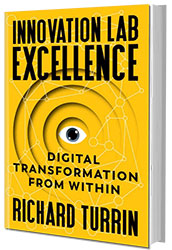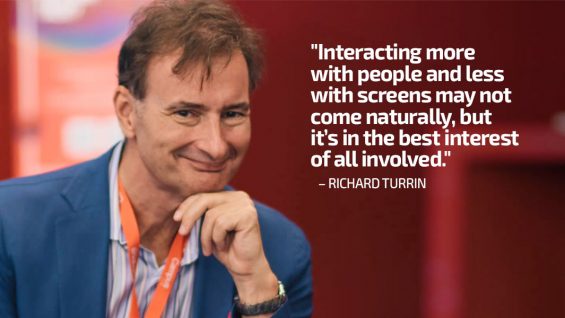What’s the most important thing for an engineer or designer in a banking innovation lab to understand? Artificial intelligence? Application Programming Interfaces (APIs)? Blockchain technology? Or tomorrow’s hot new technology that has yet to be named?
None of the above. The most critical thing for a technologist to understand is people.
This may come as a surprise to anyone who has seen photos of many financial innovation labs. Typically they equip their young tech staffs with dazzling huge computer screens and give them fat budgets to work with plus a combination of tech toys, recreational space, and the latest Italian cappuccino machine. The young technologists labor long, hard, and earnestly at new ways to handle financial services.
But all too often their work ends up lost in a land of “proof of concepts” that go nowhere, observes Richard Turrin, an expert on innovation labs.
It’s not because they don’t have lots of tech smarts, but what many lack is people smarts. Without the ability to communicate clearly with business units, to learn what they need, and to learn what fresh ideas they will accept, innovation lab staff may have trouble producing meaningful change, no matter how much money they can throw at a project.
 “It is so typical to see labs focus on technology and to watch them call it a breakthrough and disruptive for the organization,” says Turrin, author of Innovation Lab Excellence: Digital Transformation From Within. “Not focusing on the end users and other people who will use what they produce is the absolute worst direction that a lab can go in. That’s because proclaiming that you’ve produced the tech that is going to change everything isn’t enough. It’s all about people using it.”
“It is so typical to see labs focus on technology and to watch them call it a breakthrough and disruptive for the organization,” says Turrin, author of Innovation Lab Excellence: Digital Transformation From Within. “Not focusing on the end users and other people who will use what they produce is the absolute worst direction that a lab can go in. That’s because proclaiming that you’ve produced the tech that is going to change everything isn’t enough. It’s all about people using it.”

Industry Cloud for Banking from PwC
PwC’s Industry Cloud for Banking applies our deep industry knowledge to your specific business needs

Are You Ready for a Digital Transformation?
Unlock the potential of your financial institution's digital future with Arriba Advisors. Chart a course for growth, value and superior customer experiences.
Who Wants to be ‘Disrupted’? Nobody Ever
In fact, Turrin bridles at one of the words that usually accompanies “innovation,” and that is “disrupt.”
“Words matter,” Turrin writes. “How they are used within your organization’s innovation program is important both to the lab and to the message sent to the rest of your company. Any employee hoping to ‘disrupt’ their own operation has to be ready for commensurate consequences from your existing operation and staff.”
“Words matter. How they are used within your organization’s innovation program is important both to the lab and to the message sent to the rest of your company.”
— Richard Turrin, fintech consultant
Sometimes what top management really wants is to dynamite things and start fresh. But that’s rare.
“It’s reasonable to assume that you are instead attempting to ‘transform’ — a more positive, less threatening, set of actions,” Turrin suggests. To him, “disrupt” is a discomforting trigger word.
In Turrin’s experience, the bank innovation labs that have the largest remit and the broadest mission statements for change actually end up getting the least accomplished.
Before becoming a consultant, Turrin ran an innovation lab for IBM that served other industries’ innovation labs, including banking. He notes that the banking industry has been starting labs long enough now that some are on their second or even third director.
“I went from lab to lab, talking to their managers, and I began to realize that their problems fell into common patterns,” says Turrin. Often he found that talented young tech staffers grew increasingly discouraged because their work had been part of efforts at “innovation theater” — a massive sales job to impress shareholders and stock analysts. In other organizations, lack of communication and too much “carte blanche” resulted in innovations that didn’t connect to their institutions’ businesses.
Over time Turrin gained a sense of best practices that existed at successful labs and of misconceptions about the role of labs.
Read More:
- 4 Myths Preventing More Fintech+Banking Partnerships
- 7 Financial Institutions Taking Innovation Labs to the Next Level
‘Buy, Don’t Build’ Should be Most Banking Labs’ Motto
In his book Turrin relates how he was talking about chatbots with an employee who worked in the lab of a major financial institution. Turrin himself was setting up a chatbot for a client and asked which off-the-shelf technology the lab worker was considering. The consultant was shocked — he actually spilled his coffee — to learn that top management had authorized starting from scratch, believing that the bank’s lab should become adept at the technology.
“My chatbot project was up and working within months,” writes Turrin. “I still haven’t seen his financial company’s chatbot at work.”
Many banking leaders seem to think that having a lab means inventing everything from the ground up, a massive do-it-yourself project.
For all but the largest innovation labs, with huge numbers of skilled employees, Turrin believes DIY wastes time and money and loses the value of collective thinking that one player could never replicate.
“Managements who think it’s their labs’ job to build code are misguided. It’s a matter of bare economics,” says Turrin. “We’ve got tons and tons of young people out there building better mousetraps in the digital space. Their costs are low — they’re working out of their mother’s garage. They and their collaborators have been thinking about the same challenge your innovation is considering for much longer.”
Turrin doesn’t think innovation lab employees should concentrate on being inventors, but on developing processes for researching, evaluating, setting up, and testing new tech products.
“The idea is that they should be able to bring tech developed elsewhere into the bank, make it stand up and work, and determine if it’s going to solve big problems for you,” says Turrin. “If it can help, fine, go forward with it. If not, ditch it —as fast as possible.”
“Your cost could be simply that of running a proof of concept with them,” says Turrin.
He is not saying lab staff should never build things. Some applications in banking are so unique that the lab may need to develop specific software, or build on top of something that an outside firm constructed, or bridge multiple systems.
“But labs should limit the cases where they develop things, and should convince management that it’s not what their job should be,” Turrin says.
Read More:
- Consortium Provides Powerful Innovation Platform for Smaller Banks
- Every Financial Institution Must Embrace Digital Transformation Now

Innovation Shouldn’t be a License to Go Off Mission
An innovation function has come to be an essential for all financial institutions, according to Turrin. However, there are misconceptions about exactly what this entails.
“Innovation is not just putting a lab together but also making deep managerial changes within the organization,” says Turrin. How far an institution goes often depends on what top management is looking for. Some leaders only want greater efficiencies out of their innovation efforts. Others truly want to shake up everything.
“Well, go invent something. Come back in a year and show me what you’ve got.”
Something Turrin saw frequently was a philosophical difference between innovation activities and the rest of the institution. “Many of the labs I’ve seen were in corporations where there were tight limitations on what regular business units could do, what they could spend, and what kinds of jobs they offered,” says Turrin. “Everybody in those units was a Lego block stuck into another Lego block.”
What amazed him was the same hard-driving CEOs who controlled expenses with a C-clamp set up their labs and sent them off with, “Well, go invent something. Come back in a year and show me what you’ve got.”
The problem with that is that young technologists deeply want to change the world and bring modernization to banking. In the absence of communication with the rest of the organization, they can easily go off course.
“The CEOs hesitated to put limits on what the labs could do,” Turrin says. But after a couple of years, this lack of focus took innovation down less-useful paths in some labs. The laissez-faire leaders, he says, often decided, “This lab stuff doesn’t work well.”

The Power of Localized Marketing in Financial Services
Learn how to enhance your brand’s local visibility, generate more leads, and attract more customers, all while adhering to industry regulations and compliance.
Read More about The Power of Localized Marketing in Financial Services

Navigating the Role of AI in Financial Institutions
83% of FI leaders agree investing in AI is essential for 2024 but how you leverage AI is instrumental in success and meeting customer expectations.
Read More about Navigating the Role of AI in Financial Institutions
Innovate Like You Were Writing a Banking Symphony
Turrin thinks freedom with the constraint of getting an institution where it needs to go is key. He uses a musical example to explain this.
In the days of classical composers like Mozart and Bach, musical forms were highly regimented. “They were creative geniuses,” says Turrin, “but they accomplished their creativity within a framework of what was then considered music. Bach and Mozart did really well with some limits and I think most labs would do so too.”
He thinks young technologists will be happier in some labs with some lines established. Watching months of efforts dead-ended is soul-eroding. ” They want to see things they build get used somewhere.”
Beyond adding structure to innovation efforts, the technologists must interact with business units. Turrin believes a lab’s top priority ought to be getting business unit staffs ready and willing to accept change.
“Interacting more with people and less with screens may not come naturally, but it’s in the best interest of all involved,” Turrin writes. And they have to get used to the idea that at some point functions like Compliance and Legal will have to weigh in. This is still the banking business.
Internalizing innovation in this way helps spread the word that change is inevitable, according to Turrin.
“The real game today is how are you going to transform the overall institution to understand how fundamentally people are changing how they bank,” says Turrin. “They don’t want to do the same old thing, just on a smart phone.”








